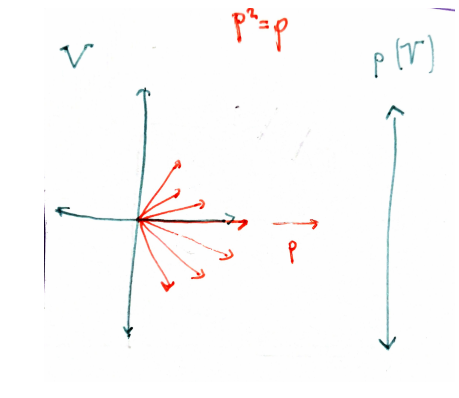Projections
Given a vector space $V$, a projection is a map
$$ P:V \longmapsto V $$such that $P^2=P$.

Informally speaking, for a projection you not only need to specify the "target" subspace, but also a "direction" along which to project (the red vectors in the picture above). So, in some sense, a projection gives us a decomposition of the vector space $V$ in horizontal and vertical subspace.
In finite dimensional vector spaces $V$, the subspaces $U=Im(P)$ and $W=Ker(P)$ satisfies:
- $P|_U$ is the identity operator.
- $V=U \oplus W$. Every $x\in V$ can be decomposed
Other properties, valid even for infinite dimension:
- The only eigenvalues allowed for a projection are $0$ and 1, even in complex vector spaces.
- The product of two projection is not, in general, another projection. But it is true when they commute.
- Even more generally, projections are maps that have a right inverse: $P\circ f=id_{im(P)}$
When we work in a Hilbert space $H$ instead of in a plain vector space $V$, we can say that $P$ is an orthogonal projection if
$$ \langle Px,y\rangle=\langle x,Py \rangle $$that is, is a self adjoint operator.
They satisfy the following properties:
- Being orthogonal is equivalent to the fact that the image $U$ and the kernel $W$ are orthogonal subspaces: let $u\in U$ and $w\in W$ then $u=Pu'$ and $Pw=0$ so
Reciprocally, any projection $P$ such that $U$ and $W$ are orthogonal satisfies, assuming $x=u_1+w_1$ and $y=u_2+w_2$
$$ \langle{Px},{y}\rangle=\langle{P(u_1+w_1)},{u_2+w_2}\rangle=\langle{u_1},{u_2}\rangle $$and
$$ \langle{x},{Py}\rangle=\langle{u_1+w_1},{P(u_2+w_2)}\rangle=\langle{u_1},{u_2}\rangle $$and therefore $P$ is self-adjoint.
- Given any closed subspace $U$ of $H$ it there exist an orthogonal projection $P$ such that $im(P)=U$. The proof (wikipedia) goes through taking the infimum of the distance...
- If $P$ is an orthogonal projection, $I-P$ is an orthogonal projection and
Proof:
First,
$$ (I-P)^2=I^2-2P+P^2=I-P $$And secondly, $x\in H$, $(I-P)(x)\in Ker(P)$ since
$$ P(I-P)(x)=Px-Px=0 $$$\blacksquare$
- Orthogonal projections are bounded operators. From Cauchy-Swarth
and so
$$ \|P v\| \leq\|v\| $$This is similar, in some sense, to saying that is continue.
- Suppose $U=im(P)$ has dimension 1, and we take a length 1 vector $u\in U$. If we fix an orthogonal basis we can express
or
$$ P=|u\rangle\bra{u} $$in Dirac bracket notation. I guess that is like taking an element of the tensor product $H\otimes H^*$.
This formula can be generalized for a projection on a subspace $U$ of any dimension $k$. Choose an orthonormal basis of $U$, and take their coordinates with respect to the main orthonormal basis to form a matrix $A$. Then
$$ P=A\cdot A^* $$________________________________________
________________________________________
________________________________________
Author of the notes: Antonio J. Pan-Collantes
INDEX: